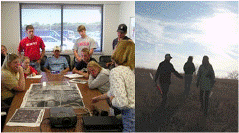Environmental and Sustainability Studies Program

Department of Environmental Studies: Undergraduate Student Theses
Date of this Version
Spring 2015
Document Type
Thesis
Citation
Environmental Studies Undergraduate Student Thesis, University of Nebraska–Lincoln, 2015
Abstract
Over the past several decades, expanding eastern red cedar (Juniperus viginiana) populations have altered prairie and grassland ecosystems in the Great Plains, causing a reduction in livestock grazing capacity. This study examined the effects of eastern red cedar removal on cattle forage coverage located on private property in northeastern Nebraska. An analysis of collected field data obtained using a line intercept method in a control and an experimental plot was performed on Elymus canadensis (Canada wild rye), Poa pratensis (Kentucky bluegrass), and Bromus inermis (smooth brome), three common grassland species that serve as forage for cattle.
Results show Canada wild rye responded negatively to the eastern red cedar removal, with a coverage declining from 58 cm in 2012 to 0 cm in 2014. Kentucky bluegrass initially responded negatively, declining from 1161 cm in 2012 to 217 cm in 2013, but responded positively in 2014, increasing to 414 cm. Smooth brome also experienced a similar response to cedar removal, declining from 736 cm in 2012 to 42 cm in 2013, but increasing to 234 cm in 2014.
Statistical variances were not analyzed, which would help determine the magnitude of the effects the removal had on forage species, if any. Further data collection and analysis are needed to more accurately determine whether or not forage coverage will continue to increase and exceed the initial coverage recordings in 2012 with the Eastern red cedar present and provide an economic return for the ranchers.


Comments
Copyright © 2015 Elise Jarrett